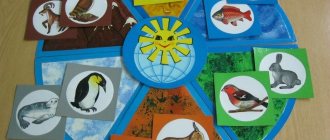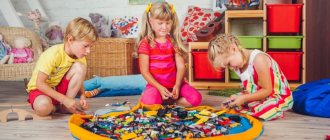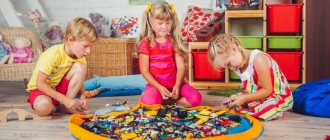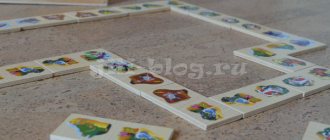Card index of board and printed games
When does this happen?
Didactic task
: To consolidate children's knowledge about the seasons. Cultivate attention, observation, partnerships.
Game rules
: Act on the teacher’s signal. Maintain the order.
Game action
: Compiling the seasons according to signs on the circles of Lull. Compiling a short story about the time of year according to signs.
Didactic material
: Lull circles for each child with story cards will be accepted.
Progress of the game
Children are given Llull circles with story cards for the seasons. Children should pick up story cards for the seasons in all circles and tell:
On the smallest circle, the state of the sun: the sun with rays, behind a cloud, without rays, etc.
On the second circle there are trees and plants according to the seasons: with leaves, with yellow leaves, snow-covered trees, etc.
In the third circle, activities for adults and children at different times of the year: swimming in the river, sledding, picking vegetables in the garden, etc.
— This time of year is summer. Because the sun is shining brightly. There are green leaves on the trees and flowers are blooming. People sunbathe and swim in the river.
— This time of year is spring. Green leaves appear on the trees. Streams run along the paths. The sun is shining, but the rays are still small. People took off their warm clothes and put on jackets and rubber boots. Etc.
What wind?
Didactic task
: To consolidate children’s knowledge about the phenomena of inanimate nature: the properties of wind.
Game rules
: Determine the positive or negative properties of the wind.
Game action:
They look at the plot picture and determine which wind is good or bad.
Didactic material
: plot pictures about the wind.
Progress of the game
The teacher displays a picture on a magnetic board. Children must determine which wind is good or bad?
— A window open from the wind, a broken vase on the floor.
— The girl cleans the room with a vacuum cleaner.
— The children are flying a kite.
— The girl calms the crying child and hands him a balloon.
— A boy launches a boat on the water.
— Strong wind in the forest and broken trees.
— There is a strong wind outside, and the children are walking in the yard.
Pick up the key
Didactic task:
To consolidate children's knowledge about the phenomena of inanimate nature: the sun, the moon, clouds.
Game rules:
Children select pictures of the corresponding color, assemble the picture and find the corresponding object from the picture. They guess riddles at the teacher’s signal.
Game action
: Collect cut-out pictures, find the corresponding object, guess riddles. Dialogue between teacher and children.
Didactic material
: cut-out pictures with the image of a key - colored, according to the number of children. Volumetric objects - keys of different shapes. A chest with riddles.
Choosing a game taking into account the characteristics of the child’s age development
The choice of gaming material is determined by the age group of the children. At the age of 5-6 years, board and printed games take into account such developmental features as:
- the need to work in small groups (2-4 people). Lotto and dominoes with pictures, cubes, puzzles (for example, “Fold the pattern”) are suitable for this.
- awareness of teamwork. The games from the previous paragraph and others, for example, games with a field card, correspond to this feature. Materials are actively used to consolidate knowledge about types of transport and the use of objects;
- At this age, it is possible to show intolerance towards the help of a teacher or other adult, which requires independence in the game process. The eldest retains the role of leader. A lesson with the designation of opposing concepts, tasks for mastering professions, is suitable.
When working with children, make sure that everyone has enough props. Each child should have their own set of cards, chips or puzzle pieces. When first introduced to the material, students will need time to study what is proposed before the game begins. In the older group, children are offered different puzzle plots, since the process of combining elements itself fades into the background. If they have free time, children can exchange sets of mosaic elements.
Timing game plan
All elements of the educational process in kindergarten must be strictly timed. Only in this case there will be no violations of discipline, and all new information will be perceived as efficiently as possible. The game plan consists of 3 important stages:
- Introduction – 1–2 minutes. The teacher explains or reminds the rules of the game and distributes the necessary materials. If they are already prepared on the tables, then the purpose of each is explained.
- The game itself takes 3–7 minutes. The teacher helps and guides the children’s actions if necessary.
- Summing up – 1–2 minutes. At this stage, it is important to praise each participant, regardless of the success of the results of his game.
Even the lotto game is played under the supervision of an adult
An example of the timing of the game “Where can I buy this?”
When studying the topic “Shopping,” the teacher explains to the kids in which departments of the store this or that product is sold. The purpose of this game is to consolidate children’s knowledge about various products and departments of stores (grocery, hardware, etc.), develop the ability to navigate the environment, and cultivate a desire to help adults.
- Explanation of the rules: children discuss where mothers buy certain products, then the adult hands out small pictures of the products, and hangs a large poster on the wall depicting various departments of the store (2 minutes).
- Children arrange the pictures into the appropriate sections, explaining their choice (2 minutes).
- Summing up (3 minutes).
Game “Where can I buy this?” develops the preschooler’s ability to navigate the world around him
Board games for children 3-4 years old (middle group)
From the age of 3, a child already actively communicates with peers around him and is able to study and discover something together with them. At this stage, board games for children 3-4 years old can acquire new rules, and the teacher acts as an arbiter on the “field”. The joint activity is designed to develop a sense of justice - kids learn to rejoice not only in personal victory, but also in the success of their peers. The girl will be happy to enthusiastically play dress-up games, be it paper heroines with various homemade outfits or three-dimensional dolls. Dress up games can be fun not only for the sake of variety of leisure time, but also for the sake of understanding the principle and algorithm of putting on clothes. The boy will cope well with not the most complex construction set.
Those board games for children 3-4 years old that were successfully accepted by children in the younger group of kindergarten may be a little more complicated for the middle group. For example, the task set for the child will not just name the object in the picture, but give it a versatile characteristic (color, features, purpose). Develop children's speech by asking them to answer questions in detail, use facial expressions, and pronounce individual sounds.
| “My House” Children are offered separate parts of a house (door, windows, chimney, staircase) or room (sofa, chandelier, painting, refrigerator), which must be assembled into one structure. At the same time, each added detail must be voiced and reasoned. A 4-year-old child can make an arrangement using his own apartment as an example. |
| “Loto” Children are given cards with different images. From the common box, the teacher (or one of the children) takes out one chip at a time and names what is depicted on it. Kids should carefully study the cards for consistency. Whoever fills out their card correctly the fastest wins. |
| “Cubes” It is necessary to make pictures by matching all sides of the existing cubes. These are complicated puzzles. |
Multifunctional didactic game “Help put things in order”
Author's game for children of senior preschool age for a subgroup of children or individual activity.
We conceived this game for preschoolers in the preparatory group to show them the orderly arrangement of household items in the house and awaken the desire to maintain this order. The children showed interest in creating a play set: they participated in choosing pieces of furniture, dishes, clothes, shoes, toys and other necessary things located in each room of the house or apartment; helped to paint and cut them out, and participated in creating the interior of the rooms.
Purpose of the game
: to form ideas about the organization of life in the family.
Training tasks
: expand and clarify ideas about household items, their properties and purpose; activate the dictionary on the topic “My Home”.
Developmental tasks
: develop visual and auditory attention, memory, coherent speech, mental operations of comparison, generalization, grouping, the ability to navigate the space of a picture.
Educational tasks
: to cultivate interest in games with peers, the desire to maintain order in the house.
Game description
The game set “Help put things in order” includes 5 game cards of A 4 format depicting 5 rooms in an apartment/house and 50 cards measuring 3x3 cm and 4x4 cm depicting household items. In the hallway, living room, nursery, kitchen and bathroom, with the help of preschoolers, we depicted furniture and equipment that corresponded to the purpose of the premises. On small cards, among others, the following items are presented: for the living room - a book, an armchair, a clock, a sofa cushion, a sofa, a vase; for children - toys pyramid, pencil, clown, book, ball, puppy, car, house, bear, kite; desk lamp; for the kitchen - bowl, cutting board, frying pan, spoon, fork, knife, saucepan, kettle; for the hallway - hat, gloves, slippers, scarf, hanger, rug, umbrella; for the bathroom - soap, shampoo, washcloth, towel, toothpaste, toothbrush.
Let's put things in order together
Rules of the game.
Option 1 . The game involves 1-5 children. Large cards with images of rooms are located on the table with the picture down. Each participant in the game chooses one card and turns it over. The leader creates a mess in the rooms: he mixes all the small cards, distributes them among the rooms and invites the preschoolers to remove them from their room and put cards with pictures of objects that are not intended for it in the center of the table. We invite the children to explain their choice. If from 2 to 5 children participate in the game, then the preschooler who completed the task the fastest wins. If only one child participates, then the speed of completing the task is not taken into account.
Option 2
. Children clean up the rooms, as in version 1 of the game. Then each child chooses from all the objects removed from the rooms and located in the center of the table only those that are suitable for his room.
Option 3
. Images of everyday objects are already laid out on large cards. The presenter invites the children to look at them and leave only those that are suitable for each room.
Lotto “Everything has its place”
Rules of the game.
Option 1 . From 2 to 5 children participate in the game. Each preschooler chooses one image of the room. The presenter has small cards with images of household objects, he names them sequentially and shows pictures. Children place these cards in rooms, taking into account the purpose of the objects. The child who collects all the items for his room the fastest wins.
Option 2
. After preschoolers have placed objects in the rooms, the presenter asks them to name the location of the specified object in relation to other things.
Option 3
. Small cards lie in the center of the table. The presenter invites the players to choose for their room only those items that have the property he named. For example: find all yellow objects; place all soft objects in the room; Place only fragile items in the room. The child who collects the most objects with the specified properties in the room wins.
Option 4
. This version of the game involves from 2 to 5 or more children. Each participant has their own task. For example, we ask one child to find all the soft objects in the apartment, the second - all the hard objects, and the third - all the light objects. The one who completes the task faster wins.
“Help Clean Up” game set
in the NOD "Our Apartment".
Tasks
: clarify and expand vocabulary; develop speech hearing, visual attention, memory, dialogic speech.
Progress of the game
The teacher places images of rooms on nearby easels, invites the children to look at them and name them. Preschoolers name the kitchen, bathroom, living room, hallway and children's room. Then the teacher draws the children’s attention to the subject pictures on the table and asks them to name the pictures one by one. When all the pictures have been examined and named, he suggests combining them into groups based on functionality and naming them using general words: dishes, clothes, toys, furniture and others. Preschoolers complete the task.
At the next stage of the activity, the teacher invites the children to place these pictures on easels under the images of rooms suitable for them.
Preschoolers take one picture at a time, name them in turn, indicate the purpose of the objects and choose rooms for them. For example: This is a sofa. It is needed to rest and sleep. The sofa is in the living room. This is a racing car. She is needed to play. The car is in the children's room along with other toys.
As the tasks progress, the teacher asks clarifying questions; creates conditions for children’s participation in discussing the properties and purpose of household items, turning to their experience; encourages participants in the dialogue. You can use the game set to solve other problems, for example, to strengthen counting skills or solve descriptive riddles.
Svetlana Voronina
teacher, MBOU d/s No. 13 , Pavlovo, Nizhny Novgorod region.
Dominoes "Fairy-Tale Heroes"
Children's age: 3-5 years.
Material: cards with drawings of heroes of the Violet Forest – 200 pieces. cards with drawings of the characters’ halves – 400 pieces. They are dismantled in smaller batches.
Instructions for the game:
1. Domino game in the usual version: cards are distributed to children in 6-10 pieces. Choose a driver in any way. Children follow each other, putting their cards on the field. If necessary, take additional cards in the “bazaar”. The winner is the one who first runs out of cards and there are none in the “bazaar”.
2. Lay out the cards one after another, without repeating the character’s drawing, but placing a different one each time - Geo, Raven, Lopushok, All, Slice, Fifa Caterpillar and so on. Calculate how long the path would be if you do not repeat the drawings of the characters.
3. Build columns of pictures, where in the first column the first picture is Baby Geo. Second column, first picture – Raven Meter. Third column, first picture – Lopushok. And so on. At the same time, place identical heroes in the first row in each column. For example, in the first row everyone has Mishik, in the second row there is the kitten Timoshka, in the third there is Invisible All. Count how many columns there are, how many rows there are in each column.
4. Tasks for the children - to populate a house with 5 floors and 5 entrances so that the inhabitants do not repeat themselves. Baby Geo went to visit his friends - in the first entrance he went 2 floors up - who did he come to visit?, on the 3rd floor he went 2 apartments to the right - who did he come to?, from there he went to ... any direction . The kid came to the middle apartment on the middle floor - who was he visiting? Where can he go now (direction of movement and number of floors or apartments) - the game “Fly”.
5. Build a table of dominoes - 2x2, 3x3, 4x4, 5x5, etc., so that the drawings of the characters do not repeat. We ask the children who stands where, who is friends with whom, who is above whom, below whom, who is the neighbors on the right, on the left, standing between whom. Various options for questions on plane orientation.
"Permutations"
Children's age - from 3-4 years - easy tasks on 3-4 cells of the "Carpet Chest", 4-7 years - tasks on 4-10 cells of the "Carpet Chest".
Objectives of the game: - to develop and improve the ability to examine the conditions of problems, the ability to plan solutions to problems, the ability to consciously solve problems to the end; - develop attention, memory, thinking, observation, concentration, visual perception; - develop the ability to navigate on a plane - left, right, up, down, up right - Peacock, down right - Pony, up left - Lion, down left - Doe; - develop counting skills - the number of steps in cells, subtract a smaller number from a larger number.
Materials and equipment: “Carpet Box”, cards of numbers of any variant (animal figures, numbers from the game “Transparent Number”, “Dominoes”, a set of numbers on a carpet).
Progress of the game.
Option 1. For children of senior preschool and primary school age. On the “Carpet Casket” in the first row, in each cell on top there are numbers from 1 to 10 in order. One of the numbers is missing - 1, 2, 3, 4, 5, 6, ..., 8, 9, 10. (no 7).
On the second row, the numbers from 1 to 10 are arranged in random order. No number is the same as in the first row. 2, 5, 6, 1, 3, …., 10, 4, 8,9. (no 7).
Task: rearrange the numbers in the second row so that they are the same as in the first, in ascending order.
Condition: you can only put a number in an empty space.
Game situation: identical numbers (little animals) walked in pairs along the paths of Kovrovaya Polyana, but one of them wanted to have fun and ran away from his friend, and then got lost. Let's guys help him find and catch up with his friend.
Questions for children:
— neighbors of numbers in the first row; who is behind what number; who is in front of some number; who stands between two numbers; who comes after a certain number; who is fifth (any) from the end. - who is in first place in the second row; who is 2nd, 3rd, 4th, etc; who stands before 5, after 4, behind 7, between 4-6, etc. - what is the number to the right above 6 on the second row; bottom left of 5 in the first row; any question on orientation - Lion, Peacock, Pony, Doe; — what number is missing in the first row? – 7; - Which seat is empty in the second row? – 6th cell; — where is the number that needs to be put here? – number 6 is in cell 3; — what number can we put in its place? – 6; - how to do it? – move 6 by 3 cells to the right; - how to check if we did it right? – 6-3=3 steps to the right; — what next number can we put in its place? Which cell is empty? – put the number 3 on the 3rd cell; - Where is the number 3 now? – on cell 5; — how should we move it? - left 2 cells; - how to check? – 5-3=2 steps to the left; - which cell is empty and what number can we put there? – in cell 5 you can put the number 5; — where is 5 now? How can I move it to its place? – the number 5 is in the second cell, move it 3 cells to the right; - how to check? – 5-2=3 steps to the right; - what will we do next? – empty 2nd cell, put the number 2 in it, now it is in 1st cell, move it 1 step to the right, check 2-1 = 1 step to the right; - what do we do next? – empty cell 1, number 1 is in cell 4, it must be moved 3 steps to the left, check 4-1 = 3 steps to the left; - the following actions? – empty cell 4, number 4 is in cell 8, it must be moved 4 steps to the left, check 8-4 = 4 steps to the left; - what's next? – empty cell 8, number 8 is in cell 9, you need to move it 1 step to the left, check 9-8 = 1 step to the left; - further? – empty cell 9, number 9 is in cell 10, you need to move it 1 step to the right, check 10-9 = 1 step to the right; - and what is the last number out of place? – number 10, it is in the seventh cell, you need to move it to the right 3 steps, check 10-7 = 3 steps to the right; - now all the numbers are in their places, are they the same in the first and second rows? - Yes; — what number is missing in both rows? - 7.
Option 2. Starting from 3 years.
On the “Carpet Casket” in three cells on the first row there are any two figures (there can be: images of geometric shapes, objects, letters, numbers, people, heroes of the “Purple Forest”, animals, transport - on any topic currently being studied in group).
In the second row, below them, in three cells, these same two figures are located in a different order (for example, in the 1st row - a square, an empty cell, a circle; in the 2nd row - an empty cell, a circle, a square).
Task: rearrange the figures in the second row so that they are in the same order as in the first row.
Condition: you can only place a piece on an empty space.
Children can rearrange the figures themselves on the “Carpet Casket” one by one; The teacher encourages the children to pronounce the necessary actions: which cell is free, what needs to be placed there, where the desired figure is, how the figure can be placed - how many cells to the right or left it needs to be moved.
For children who successfully complete different versions of tasks and exercises, a larger number of cells are used in the game - 4, 5, 6 and up to 10.
The whole group of children on their “Mini-Larchiks” does the same work as on the “Kovrograph Chest”. You can first ask the children to rearrange the figures on their mats themselves. Then check how it turned out on the Carpet, each time the child must pronounce his actions - which cell is empty, which figure needs to be put there, where this figure is, how to move it to the empty cell.
Options for solving problems may be different for each child, depending on the arrangement of the figures. When children cope with easy tasks on 3 cells, we increase the number of cells from 4 to 10.





